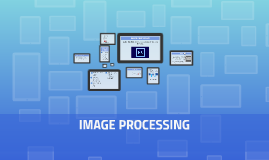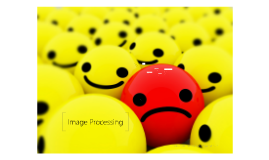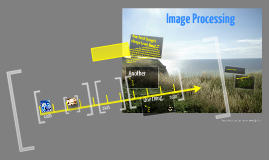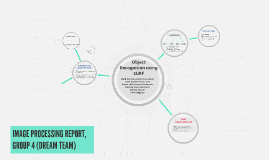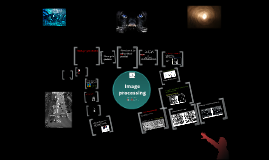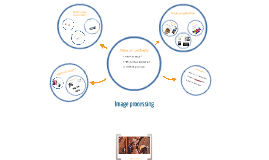Image Processing
Transcript: Image processing is a method to convert an image into digital form and perform some operations on it, in order to get an enhanced image or to extract some useful information from it. Image processing basically includes the following three steps: Conclusion • Learning - (from an image file and corresponding text fiile or learning interactively • Extraction and isolation of individual characters from an image • Determination of the properties of the extracted characters • Comparison of the properties of the learned and extracted characters • Additional operations on extracted characters if no good match is found Turns images of machine-printed characters into machine-readable characters As per the above example "Basic". We maintain the LeftXindex and RightXindex for each character. The LeftXindex represent the left most index of the character in the bitmap specified initially in the blog. The RightXindex represent the right most X coordinate of the character. When the difference coordinates of current character and previous character is less than 3 pixels then they are joined. By highlighting the boundary (X, Y) coordinates of the connected component "a". B A S I C 2010 • Importing the image with optical scanner or by digital photography. Optical Character Recognition (OCR) The label equivalence relationships generated are Set ID Equivalent Labels 1. 1 2 . 2 3 . 3,7 4 . 4,8 5 . 5 6 . 6 7 . 3,7 8 . 4,8 The Working Four basic algorithms are used when implementing the system: • Image labelling. • Finding boundary and Generating X, Y coordinate pixel array. • Matching connected pixels with learned set (.xml). • Forming words. A presentation made by: Priyanka Adhikari (01) Manasi Pradhan (20) Paras Sachdeva (25) On the second pass: Finding boundary and Generating X, Y coordinate pixel array: Four basic algorithms • Image labelling. • Finding boundary and Generating X, Y coordinate pixel array. • Matching connected pixels with learned set (.xml). • Forming words. • Magnetic Ink Character Recognition (MICR) Few methods of OCR used. Forming words: On the first pass. CHARACTER RECOGNITION • Optical Mark Recognition (OMR) • Barcode Recognition < characterinfo> < ParamValue >a>⁄ParamValue> < PixelInfo > (0,3)(0,4)(1,0)(1,2)(1,5)(2,0)(2,2)(2,5)(3,0)(3,2)(3,5)(4,1)(4,2)(4,3)(4,4)(4,5) < ⁄PixelInfo > <⁄characterinfo > LeftXCor: - Starting left X coordinate of the connected component. For the connected component "a" it is 0. RightXCor: - Ending left X coordinate of the connected component. For the connected component "a" it is 4. TopYIndex: - Starting or the lowest Y coordinate of the connected component. For the connected component "a" it is 0. BottomYIndex: - Ending or the highest Y coordinate of the connected component. For the connected component "a" it is 5. Analyzing and manipulating the image which includes data compression and image enhancement. Text Detection and Character Recognition in Scene Images Image labeling algorithm 2004 OMR technology detects the existence of a mark, not its shape. OMR forms usually contain small ovals, referred to as 'bubbles,' or check boxes that the respondent fills in. ICR reads images of hand-printed characters (not cursive) and converts them into machine-readable characters. In the report we have covered introduction of our main domain Image Processing.We explained an al LeftXCor: - Starting left X coordinate of the connected component. For the connected component "a" it is 9. RightXCor: - Ending left X coordinate of the connected component. For the connected component "a" it is 13. TopYIndex: - Starting or the lowest Y coordinate of the connected component. For the connected component "a" it is 4. BottomYIndex: - Ending or the highest Y coordinate of the connected component. For the connected component "a" it is 9. 2007 2013 MICR is a specialized character recognition technology adopted by the U.S. banking industry to facilitate check processing. Output is the last stage in which result can be altered image or report that is based on image analysis. Types of Recognition Engines • Image selection • Text Extraction from the image • Skew Correction • Binarization of the image • Segmentation into text lines •Recognition of the character back from binary. A barcode is a machine-readable representation of information. Barcodes can be read by optical scanners called barcode readers Advantages of OCR:- -It is cheaper and much faster. -It is used to recreate tables and original layout. -It is much efficient -Easy access for handicapped person:OCR software possesses a feature that helps blind users to scan books, magazine at their leisure by use of sound. -If we lose important documents, OCR software helps to replace it. It allows to scan the original print document or the most recent version. Disadvantanges of OCR:- -It doesn't always read characters correctly. Sometimes it is because of the quality of print but there are a lot of characters that get confused. Classic examples include the






